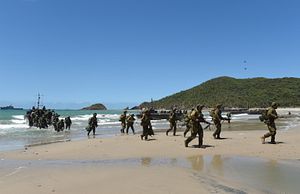As China appears to be signaling the end of its tacit approval of Singapore’s military training in Taiwan, the recent signing of the Australia-Singapore Comprehensive Strategic Partnership (CSP)’s Memorandum of Understanding (MOU) on Military Training and Training Area Development is particularly timely. Singapore and Australia share a number of strategic commonalities that have drawn them together as partners, forming a nexus, or perhaps model, for a growing camp of states wishing to make meaningful steps in Southeast Asian security inside the contested space between the two primary Pacific powers, namely China and the United States. Exercise Trident, a bilateral exercise concluded in early November 2016, exemplifies this strategic convergence.
The MOU, signed on October 13, 2016, provides access to Australian territory for increased unilateral training of Singapore Armed Forces (SAF) over a period of 25 years, with Singapore investing AU$2.25 billion (US$1.7 billion) into jointly funded improvements to Queensland’s Shoalwater Bay Training Area (SWBTA) and Townsville Field Training Area, to include a new live-fire urban operations training ground. Singapore gains access to improved training and training area equaling over 10 times the size of its own nation, while Australia deepens a relationship critical to safeguarding its most important strategic maritime approach.
Strategically, Australia and Singapore align in two key areas outlined in the most recent Australian Defense White Paper. First, both countries have a vested and real interest in the United States remaining deeply engaged in the Asia Pacific region. Australia is a key ally of the United States and partnered U.S. forces in every major conflict for a century, while Singapore is home to the most significant U.S. military footprint in Southeast Asia. Second, both countries need China to continue its rise successfully, and peacefully. China is the number one trading partner of both states, representing tens of billions of dollars in annual trade to each. It is simply unreasonable to expect either state to choose between the United States and China. The defense agreements within the CSP represent a way for both Singapore and Australia to improve their regional security environment and bilaterally enrich a rules-based legalistic order in the Asia Pacific region.
The SAF’s conclusion of Exercise Wallaby, of which Exercise Trident is a part, marks the 26th year of SAF annual training at the SWBTA; but more significant than the extended history of the exercise is its import with regard to the future of the defense relationship. Exercise Trident is, and will increasingly be, a useful bellwether for the positive trend of the Australia-Singapore strategic relationship within the framework of the CSP, being the first bilateral, tri-service exercise conducted by the two nations, now ensconced by the CSP as the signature joint bilateral exercise between the SAF and Australian Defense Force (ADF). A fixture since 2013, the exercise began as a Humanitarian Assistance and Disaster Relief (HADR) ship-to-shore movement involving 900 SAF personnel and only 14 Australian personnel.
This year’s exercise ran from October 28 to November 4, beginning with several days of force integration training with over 2,100 total personnel involved from both militaries, culminating in a sophisticated combined joint operation involving a battalion-level amphibious landing launched from Republic of Singapore Navy LST-208 RSS Resolution, working in concert with a battalion-size helo-borne insertion force to seize an inland objective under cover of Republic of Singapore Air Force AH-64D Apache attack helicopters. The increase in size, scope, and complexity over the space of four years speaks volumes as pertains to the value of this exercise for Singapore in particular. As Singapore seeks out other Third Generation forces to hone its abilities, Exercise Trident provides an excellent opportunity to train alongside a highly proficient ADF well versed in addressing both expeditionary combat operations and non-traditional security missions, both desired areas of improvement for SAF. As the exercise matures, Singapore’s capabilities and reputation as a guarantor of regional security will likely correspondingly increase.
The relationship between Australia and Singapore is exemplary in its pragmatism. The two states don’t agree on everything, but in the areas of alignment there has been significant progress in a fairly short amount of time. The regional demand for HADR operations provides impetus for the two most technologically advanced and capable militaries in the region to cooperate, and events such as Exercise Trident will strengthen the strategic bond between them, as well as prepare their forces to work together at the tactical level. As the United States and China jostle over what the defense picture in the Asia Pacific will look like in 10 years, Singapore and Australia are shaping what it looks like today.
Blake Herzinger is an active duty U.S. Navy officer who is a postgraduate student at the S. Rajaratnam School of International Studies in Singapore. He has served as a liaison officer conducting information-sharing and relationship-building activities among U.S. allies and partners in the Asia Pacific region, and as an anti-submarine warfare intelligence officer. The views and opinions expressed in this article are those of the author and do not necessarily reflect the official policy or position of any agency of the U.S. government. He tweets at @BDHerzinger

































